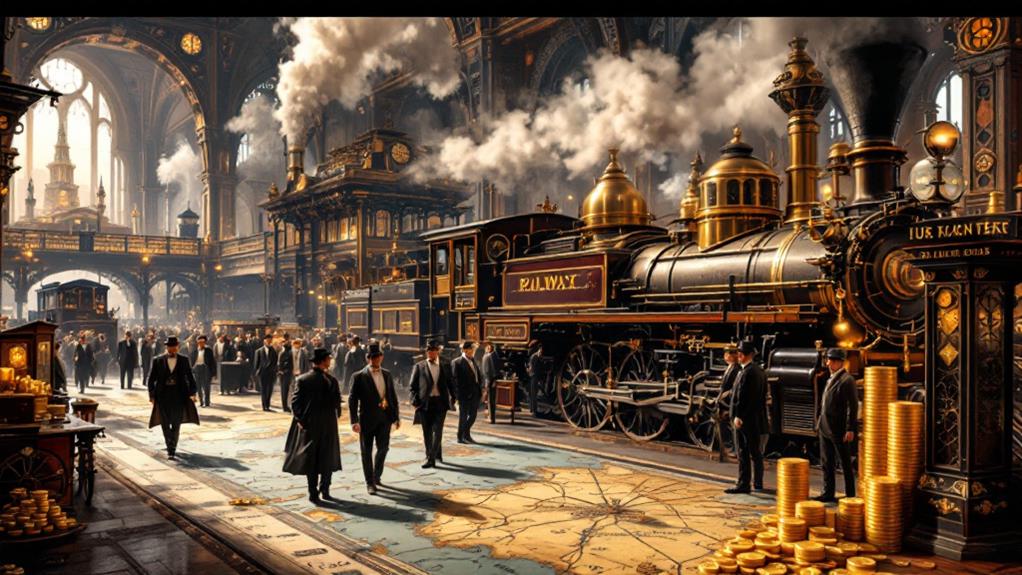Who Were the Richest People in the 1800s?

In the 1800s, a handful of industrialists amassed enormous wealth. John D. Rockefeller's fortune in oil possibly reached $400 billion, while Cornelius Vanderbilt conquered railroads and steamships, reaching $236.4 billion. Andrew Carnegie transformed the steel industry, selling Carnegie Steel for a substantial amount. Jay Gould's strategic stock manipulations brought him around $71 billion. Meanwhile, Alexander Turney Stewart made about $100 billion in retail. These pioneers didn't just profit from railroads, oil, and steel; they also impacted banking and real estate. As you investigate further, you'll uncover how their financial successes shaped society and their generous legacies.
Economic Landscape of the 1800s
How did the economic landscape of the 1800s shape today's wealth dynamics? The period was marked by industrialization, transforming the U.S. into an economic powerhouse. This timeframe, especially the Gilded Age, witnessed unprecedented economic growth, driven by key industries like railroads, steel, and oil. Railroads became the backbone of the economy, linking vast regions and enabling the efficient transport of goods and people. This industrial boom created immense opportunities for wealth accumulation.
Figures like Andrew Carnegie and John D. Rockefeller emerged as some of the wealthiest Americans, amassing fortunes that would be staggering even by today's standards. Carnegie's steel empire and Rockefeller's Standard Oil dominated their respective industries, setting benchmarks for business success and wealth concentration. Their rise symbolized the period's economic dynamics where a few individuals controlled vast amounts of wealth, often equating to a significant portion of the national economy.
The wealth generated during this time laid the foundation for modern economic structures. The concentration of wealth among a few industrialists highlighted the potential—and challenges—of capitalism, influencing today's discussions on wealth distribution and economic equity. Understanding this landscape helps you grasp how past economic patterns continue to shape current wealth dynamics.
Influential Industrialists
John D. Rockefeller, a name synonymous with oil, founded Standard Oil and controlled a substantial portion of the U.S. oil industry. His fortune, estimated at $400 billion, made him one of the wealthiest individuals in history. Rockefeller's business acumen defined the Gilded Period, showcasing the potential of industrialists' wealth.
Cornelius Vanderbilt, originally a steamship magnate, later expanded into railroads. His ventures propelled his fortune to an estimated $236.4 billion, contributing notably to the U.S. economy. Though not without controversy, Vanderbilt's impact on industry was unparalleled.
Jay Gould and Alexander Turney Stewart were also notable figures. Gould, with a fortune of $71 billion, was infamous for stock manipulation, while Stewart, with $100 billion, transformed retail through his successful dry goods business. Together, these industrialists shaped an epoch of unprecedented economic growth.
Wealth in Railroads

As the 19th century unfolded, the railroad industry emerged as a powerhouse of wealth, rivaling the fortunes of the oil and retail magnates. You'd find railroad tycoons like Cornelius Vanderbilt leading the charge with his strategic investments in steamship and railroad ventures. His wealth accumulation reached an astounding $236.4 billion, at one point equating to 50% of U.S. Treasury holdings, underscoring the massive economic growth railroads spurred.
Another formidable railroad tycoon was Jay Gould, whose aggressive tactics and stock manipulation earned him a fortune estimated at $71 billion. You might be intrigued by how Gould's shrewd maneuvers allowed him to dominate the rail industry and secure his place among the wealthiest of the time.
The railroads didn't just enrich individuals like Vanderbilt and Gould; they paved the way for others. Richard Mellon, co-founder of Gulf Oil, also amassed substantial wealth—$118.8 billion—through railroads. Meanwhile, Andrew Carnegie utilized railroad logistics to build his steel empire, showcasing how railroads' economic growth extended beyond transportation to fuel industrial expansion. The railroad industry, therefore, became a significant catalyst for wealth accumulation in the 1800s.
Oil Magnates
During the late 19th century, the oil industry saw the rise of titans whose fortunes would shape the course of American economic history. You can't talk about oil magnates without mentioning John D. Rockefeller, the mastermind behind Standard Oil. Established in 1870, Standard Oil quickly grew into a monopoly, controlling a vast portion of U.S. oil production. Rockefeller's shrewd business tactics and relentless pursuit of efficiency made him the wealthiest American in history, with a fortune that would amount to $400 billion today.
His influence wasn't limited to himself. His younger brother, William Rockefeller, also amassed considerable wealth through the oil industry, further bolstering the family's fortune and power. The oil boom, particularly in Pennsylvania, ushered in new drilling technologies and transportation methods, rapidly expanding the industry's reach.
Henry Flagler, another key figure, partnered with Rockefeller. He played a critical role in Standard Oil's success and later invested his wealth in developing the Florida East Coast Railway, enhancing oil distribution.
- Standard Oil's dominance led to its breakup in 1911.
- William Rockefeller contributed considerably to the family's wealth.
- Pennsylvania was a central hub during the oil boom.
- New technologies transformed oil drilling and transport.
- Henry Flagler expanded oil distribution through railways.
Steel Titans

In the domain of steel titans, Andrew Carnegie stands out as a key figure who transformed the American steel industry in the 19th century. By founding Carnegie Steel Company, he changed steel production using the Bessemer process, which allowed for mass production and helped the U.S. surpass the UK's steel output by 1889. Carnegie's ventures made him one of the richest Americans of his time, owning a significant share of the market.
His influence extended beyond just business; Carnegie's legacy is also marked by his dedication to philanthropy. He believed in using wealth to benefit society, contributing to educational and cultural institutions across the United States. This philanthropic spirit remains an integral part of his enduring legacy.
In 1901, Carnegie made a crucial decision to sell his steel empire to J.P. Morgan for $303.4 million, a sum equivalent to $11.1 billion today. This sale led to the creation of U.S. Steel Corporation, which dominated the industry. Carnegie and J.P. Morgan were key players in shaping the landscape of American industrial power during the Gilded Era, leaving a lasting impact on the steel industry and the nation's economic history.
Banking Pioneers
Steel titans like Andrew Carnegie laid the groundwork for America's industrial might, but it was the banking pioneers who fueled the financial engine of the 19th century. These individuals not only amassed vast fortunes but also shaped the economic landscape of their time. J.P. Morgan stood out as a towering figure in banking and finance, known for consolidating corporations and stabilizing markets during crises. His influence extended across multiple sectors, securing his place among the wealthiest.
George F. Baker also made significant strides in banking, contributing to the industry's development. His generosity was evident in his $5 million donation to Harvard Business School, highlighting his commitment to education and finance.
Andrew Mellon, co-founder of Mellon Bank, played an essential role in finance and later served as U.S. Secretary of the Treasury, impacting national policy.
Richard Mellon, another key figure, propelled the banking industry forward and expanded into railroads and oil, showcasing his adaptability.
Cornelius Vanderbilt, initially a shipping and railroad magnate, ventured into banking, exemplifying the interconnected nature of these industries.
- J.P. Morgan: Consolidated corporations
- George F. Baker: Harvard benefactor
- Andrew Mellon: Treasury Secretary
- Richard Mellon: Industry expansion
- Cornelius Vanderbilt: Diversified investments
Real Estate Giants

The world of 19th-century real estate was shaped by visionary giants who transformed vast tracts of land into lively cities and amassed staggering fortunes in the process. John Jacob Astor, a German immigrant, emerged as a real estate titan in American history. Initially building his wealth through the fur trade, Astor's strategic investments in New York City real estate propelled his fortune to an astounding $159 billion. You can see how his foresight in property development paved the way for a legacy that still echoes today.
Cornelius Vanderbilt, another name etched in the annals of real estate, is renowned for his immense wealth, which reached approximately $236.4 billion. While Vanderbilt made his initial fortune in shipping and railroads, his later ventures into real estate greatly bolstered his standing. Vanderbilt's story exemplifies the power of diversification and investment in a burgeoning America.
Richard Mellon, with a wealth estimate of $118.8 billion, also left a mark on the real estate landscape. As a prominent banker and industrialist, his ventures into real estate and finance reshaped the American economic framework. These real estate moguls didn't just accumulate wealth; they helped construct the backbone of modern American cities.
Philanthropic Legacies
Although the 19th century is often remembered for its industrial titans, their philanthropic legacies have left a comparably enduring impact. Andrew Carnegie and John D. Rockefeller, two of the wealthiest figures of their time, exemplified the responsible use of wealth. Carnegie famously articulated this in "The Gospel of Wealth," emphasizing social responsibility. He donated approximately $350 million, advocating for education and cultural institutions, with over 2,500 libraries and landmarks like Carnegie Hall and Carnegie Mellon University. His efforts were rooted in the belief that access to knowledge was essential for societal progress.
John D. Rockefeller, another philanthropic giant, contributed over $500 million to causes like education, health, and scientific research. His investments shaped the future of these fields, demonstrating that wealth could be a powerful force for good.
Consider these highlights of their philanthropic legacies:
- Carnegie Hero Fund: Recognizes acts of heroism, showcasing his commitment to social responsibility.
- Rockefeller Foundation: Focuses on global challenges, from health to education.
- Carnegie Corporation of New York: Influences American education and culture.
- Rockefeller University: Advances scientific research.
- Carnegie Museums: Foster cultural growth and education.
Their philanthropic endeavors have permanently shaped today's educational and cultural landscapes.




